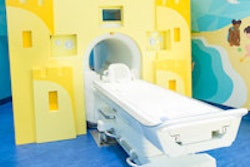A new study of MR imaging in pediatric clinical trials concluded that the risks of physical and psychological harm from the modality are no greater than risks that healthy children face from everyday activities, according to a study in IRB: Ethics & Human Research, a journal of the Hastings Center.
However, performing an MRI exam with an intravenous contrast agent or sedation increases the odds of harm and could make the risks of an MRI scan unacceptably high, the authors added.
The study, led by Dr. Matthias Schmidt from Dalhousie University in Halifax, Nova Scotia, found that the risk of physical injury from MRI is 17 per 100,000 examinations, and the risk of death is four per 100 million examinations.
By comparison, the risk of injury in children younger than 16 years from sports and recreational activities ranges from four per 100,000 hours of participation in soccer to 12,730 per 100,000 hours for ice hockey.
Assuming that an MRI examination lasts an hour, the risk of injury associated with an MRI scan falls within the lower end of this range, the authors wrote.
As for psychological harm, in studies of children ages 10 to 18 years who had MRI scans, 12% said they felt disturbed by the confined space, 16% were bothered by the noise, and 1.2% could not complete their MRI scan due to claustrophobia.
The percentages are less than the average percentages of children who report fears associated with anxiety disorders. For example, in one study of children 8 to 13 years of age, 49% reported fears associated with subclinical anxiety and 22% met the full criteria of an anxiety disorder.
The authors also concluded that while the risk of local and minor systemic reactions from MRI contrast agents (4% to 6%) is comparable to the risk of minor reactions from routine vaccinations, the risk of anaphylaxis from MRI contrast (7.5 per 100,000 doses) is higher than the risk of anaphylaxis from vaccinations.
The risk from sedation in MRI protocols, which includes gastrointestinal complaints (18% to 37%) and motor imbalance (66% to 85%), does not meet the minimal-risk standard, based on the risks posed by sedating medications such as over-the-counter cold medicines, they added.
Researchers and research ethics review boards should collaborate to minimize the risk of harm and discomfort associated with pediatric MRI research, Schmidt and colleagues recommended.



.fFmgij6Hin.png?auto=compress%2Cformat&fit=crop&h=100&q=70&w=100)




.fFmgij6Hin.png?auto=compress%2Cformat&fit=crop&h=167&q=70&w=250)











